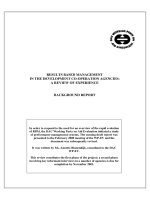Toward Incentives for Military Transformation - A Review of Economic Models of Compensation doc
Bạn đang xem bản rút gọn của tài liệu. Xem và tải ngay bản đầy đủ của tài liệu tại đây (283.5 KB, 99 trang )
This document and trademark(s) contained herein are protected by law as indicated in a notice appearing
later in this work. This electronic representation of RAND intellectual property is provided for non-
commercial use only. Permission is required from RAND to reproduce, or reuse in another form, any
of our research documents for commercial use.
Limited Electronic Distribution Rights
This PDF document was made available from www.rand.org as a public
service of the RAND Corporation.
6
Jump down to document
THE ARTS
CHILD POLICY
CIVIL JUSTICE
EDUCATION
ENERGY AND ENVIRONMENT
HEALTH AND HEALTH CARE
INTERNATIONAL AFFAIRS
NATIONAL SECURITY
POPULATION AND AGING
PUBLIC SAFETY
SCIENCE AND TECHNOLOGY
SUBSTANCE ABUSE
TERRORISM AND
HOMELAND SECURITY
TRANSPORTATION AND
INFRASTRUCTURE
WORKFORCE AND WORKPLACE
The RAND Corporation is a nonprofit research
organization providing objective analysis and effective
solutions that address the challenges facing the public
and private sectors around the world.
Visit RAND at www.rand.org
Explore RAND National Defense Research Institute
View document details
For More Information
Purchase this document
Browse Books & Publications
Make a charitable contribution
Support RAND
This product is part of the RAND Corporation technical report series. Reports may
include research findings on a specific topic that is limited in scope; present discus-
sions of the methodology employed in research; provide literature reviews, survey
instruments, modeling exercises, guidelines for practitioners and research profes-
sionals, and supporting documentation; or deliver preliminary findings. All RAND
reports undergo rigorous peer review to ensure that they meet high standards for re-
search quality and objectivity.
Toward Incentives for
Military Transformation
A Review of Economic Models
of Compensation
Bogdan Savych
Prepared for the Office of the Secretary of Defense
Approved for public release; distribution unlimited
The RAND Corporation is a nonprofit research organization providing objective analysis
and effective solutions that address the challenges facing the public and private sectors
around the world. RAND’s publications do not necessarily reflect the opinions of its
research clients and sponsors.
R
®
is a registered trademark.
© Copyright 2005 RAND Corporation
All rights reserved. No part of this book may be reproduced in any form by any electronic or
mechanical means (including photocopying, recording, or information storage and retrieval)
without permission in writing from RAND.
Published 2005 by the RAND Corporation
1776 Main Street, P.O. Box 2138, Santa Monica, CA 90407-2138
1200 South Hayes Street, Arlington, VA 22202-5050
201 North Craig Street, Suite 202, Pittsburgh, PA 15213-1516
RAND URL: />To order RAND documents or to obtain additional information, contact
Distribution Services: Telephone: (310) 451-7002;
Fax: (310) 451-6915; Email:
Library of Congress Cataloging-in-Publication Data
Savych, Bogdan.
Toward incentives for military transformation : a review of economic models of compensation /
Bogdan Savych.
p. cm.
“TR-194.”
Includes bibliographical references.
ISBN 0-8330-3786-2 (pbk.)
1. United States—Armed Forces—Pay, allowances, etc. 2. United States—Armed Forces—Reorganization.
I. Title.
UC74.S28 2005
355'.00973'0905—dc22
2005008170
The research described in this report was sponsored by the Office of the Secretary
of Defense (OSD). The research was conducted in the RAND National Defense
Research Institute, a federally funded research and development center supported by the
OSD, the Joint Staff, the unified commands, and the defense agencies under Contract
DASW01-01-C-0004.
- iii -
PREFACE
Recent efforts toward military transformation have extensive
implications for the military’s personnel management and compensation
systems. In addition to the existing goals of ensuring effective
participation of individuals in the military (attracting, retaining, and
developing qualified personnel), the compensation and personnel systems
of a transformed military should emphasize effort and performance
incentives by encouraging reasonable risk-taking and innovation, allow
for greater speed and flexibility in deployment, and support more
decentralized forces. The worry, however, is that current military
systems cannot facilitate simultaneously all the needs of a transformed
military.
This report reviews economic models of compensation in a
hierarchical organization and identifies factors within the military
compensation system that might constrain or facilitate transformation
efforts. In particular, it focuses on how lessons from these economic
compensation models can be used to increase flexibility of personnel
management and provide incentives for creative thinking and performance
and well-calculated risk-taking. Frameworks reviewed in this report are
useful in describing the behavior of military personnel and patterns of
performance in the military. This report is part of a larger project
titled “Enhancing the Flexibility of the Military Compensation System.”
The project seeks to define ways of simplifying and adding flexibility
to the military compensation system that bring value to the military
organization and support the goals of military transformation. Further
effort within the project would use existing military compensation
models to determine what changes to the compensation system would
support transformation.
This research was conducted for the Office of Compensation, Office
of the Under Secretary of Defense for Personnel and Readiness, within
the Forces and Resources Policy Center of the RAND National Defense
Research Institute (NDRI). NDRI, a division of the RAND Corporation, is
a federally funded research and development center sponsored by the
- iv -
Office of the Secretary of Defense, the Joint Staff, the unified
commands, and the defense agencies. Comments are welcome and may be
addressed to the project leaders, Beth Asch, , and
James Hosek, For more information on RAND’s Forces
and Resources Policy Center, contact the Director, Susan Everingham. She
can be reached by email at ; by phone at 310-
393-0411, extension 7654; or by mail at RAND Corporation, 1776 Main
Street, P.O. Box 2138, Santa Monica, California 90401-2138. More
information about RAND is available at www.rand.org.
- v -
CONTENTS
Preface iii
Summary ix
Acknowledgments xiii
1. Introduction 1
2. Promotion Tournaments 5
The Tournament System 5
What Is the Promotion Tournament System? 5
Promotions Are the Key Feature of Managing Personnel in the
Military 6
The Tournament System’s Attraction 6
The Possibility of Promotion Induces Employees to Outperform
Their Colleagues 7
The Tournament System Helps Sort Workers into Jobs 8
The Tournament System’s Administrative Costs 9
The Tournament Model Requires a System of Evaluating Workers .10
The Promotion Tournament System Relies on People Flowing
Throughout the Hierarchy 11
The Tournament System’s Unintended Outcomes 12
The Compensation Structure Affects a Worker’s Behavior and
Willingness to Take Risks 13
Subjective Evaluations May Inspire Unproductive Behavior by
Workers and Managers 14
A Promotion System Can Undermine Teamwork and Cooperation 16
The Tournament System’s Relevance to Military Transformation 18
The Tournament System Fits the Military Compensation System 18
Many Elements of the Tournament System Are Important in the
Military 18
How Can the Paradigm Support the Objectives of Military
Transformation? 19
3. Career Incentive Schemes: Deferred Compensation and Retirement Pay.22
Examples of Career Incentives 22
Promotion Ladders as Deferred Compensation 22
Retirement Pay as Deferred Compensation 23
Why Deferring Compensation into the Future Is Attractive 24
Deferred Compensation Induces Selection of Workers 24
Delayed Rewards Can Encourage Better Performance 25
Retirement Pay Strengthens Incentives for Performance 26
Career Incentive Schemes’ Administrative Costs 27
Career Incentive Schemes Require a Skewed Pay Structure 27
Use of Deferred Compensation Is Expensive When the Discount
Rate Is High 29
Use of Deferred Compensation Requires Voluntary or Mandatory
Separation 30
Deferred Pay Systems’ Possible Unintended Outcomes 31
- vi -
Deferred Compensation Has the Strongest Effects on Young
Workers 31
The Retirement System May Create Undesirable Patterns of
Separation 32
Relevance of Career Incentives to Military Transformation 33
Career Incentive Schemes Explain Many Elements in the
Military’s System of Incentives 33
How Can the Paradigm Support the Objectives of Military
Transformation? 33
4. Explicit Pay-for-Performance Incentive Mechanisms 35
Pay for Performance 35
Pay-for-Performance’s Attraction 36
Piece Rates Create Strong Incentives for Performance 36
Piece Rates Facilitate Sorting of People into Jobs 37
Pay-for-Performance Administrative Costs 38
The Pay-for-Performance System Requires Good Measures of
Performance 38
Firms Should Bear the Costs of Monitoring Efforts 40
Pay-for-Performance Systems’ Unintended Outcomes 41
Workers Can Shift Effort Between Measured and Unmeasured
Dimensions of Performance 41
Workers May Strategically Shift Effort Between Time Periods 42
Strong Individual Incentives Can Undermine Team Performance 43
Subjective Evaluations May Lead to Unexpected Behavioral
Responses 43
Lessons from the Pay-for-Performance System for the Efforts of
Transformation 44
Pay-for-Performance Schemes Are Not Used Widely in the
Military 44
Factors That Affect Performance 44
The Paradigm Can Support the Objectives of Military
Transformation 45
5. Rewarding Teamwork and Cooperation in the Hierarchical
Organization 47
Teamwork Is an Important Part of the Production Process 47
There Is No Single Best Approach to Rewarding Teamwork 48
Problems with Team Incentives 48
Team Effort Is Difficult to Achieve Through Individual
Incentives 49
Team-Based Incentives Do Not Reward the Most Able Workers 49
Team-Based Incentives May Encourage Free Riding 50
Overcoming the Free-Riding Effect 51
Team Incentives in the Transformed Military 53
6. Incorporating the Effects of Nonmonetary Factors 55
Nonmonetary Factors Defined 55
Human Resources Management Tools 55
Organizational Culture 56
Organizational Goals 57
Authority and Discretion 57
Nonmonetary Factors Can Affect Individual Performance 58
Flexible Personnel Practices Can Increase Productivity 58
- vii -
A Strong Organizational Culture Can Motivate Performance 59
An Organization’s Mission and Goals Can Help Sort Workers 60
Individual Authority and Discretion Might Motivate
Performance 60
Importance of Nonmonetary Factors in the Transformed Military 61
Nonmonetary Factors Are Important in the Military
Compensation System 61
How Nonmonetary Factors Can Support the Objectives of
Military Transformation 62
7. Concluding Remarks 64
Bibliography 71
- ix -
SUMMARY
This report reviews economic models of compensation that apply to
hierarchical organizations. It outlines how models of compensation can
help make the military compensation system more compatible with the
goals of transformation. Two objectives of transformation are important
here: (1) assuring that the compensation system provides flexibility in
managing personnel, and (2) assuring that the system induces innovatory
activities and well-calculated risk-taking. These aims should accompany
the usual goals of the military compensation system in providing
incentives for performance, retention, and skill acquisition.
This report is organized around four main paradigms of personnel
compensation. First, it discusses the advantages and disadvantages of
providing incentives through promotion tournaments. This is the most
important model of compensation in the military. Next, it examines how
incentives are provided in compensation systems that defer some part of
the rewards into the future. This analytical approach to compensation
applies to the military because performance in the military in the
current period is partially rewarded by higher pay in the future through
promotions and eventually retirement. The report also looks at the
benefits and costs of tying pay directly to certain performance metrics.
This approach provides the most flexibility in personnel management and
can provide strong incentives for individual performance. However, its
application in the military is limited to those occupations where
performance is easy to measure. In addition, the report outlines how
nonmonetary factors can affect performance and sorting in the
organization, and how they should be associated with monetary
incentives.
Each of these models of rewarding personnel has its benefits. A
well-designed compensation system can ensure that workers with the right
skills and abilities apply for open positions in an organization and
stay there for their careers. When deciding where to work and later
whether to separate from a firm, workers consider the compensation that
they receive and compare it to the opportunities available elsewhere. In
- x -
addition, a compensation system can ensure that employees work hard on
their jobs.
However, each of the systems of rewarding personnel has its costs.
Monetary costs of rewarding personnel include wages, costs of monitoring
performance, and possible administrative expenses. More important,
reward systems might create unintended outcomes, brought about by the
strategic response of personnel to the peculiarities of the compensation
system. Some of these unintended outcomes include the following:
o Workers may inefficiently allocate their efforts among
different tasks. If not all dimensions of the output are
rewarded, workers may prefer to work harder only in measured
and rewarded dimensions at the expense of unmeasured and
unrewarded ones.
o Incentive systems can affect workers’ risk-taking behavior.
Workers can either take excessive risks or limit their risk-
taking too much.
o Workers may strategically shift their effort between
measurement periods.
o Workers may prefer to influence supervisors’ evaluations.
When performance evaluations include subjective components,
workers may invest too much of their time into affecting the
supervisors’ evaluations, because good evaluations affect
future pay and workers’ reputations.
o Supervisors may rely on favoritism or preferences in deciding
whom to promote. This makes the evaluations less informative
about workers’ talents.
o Strong incentives for individual performance may undermine
team effort and team performance.
o Strong incentives for individual performance may mute effects
of nonmonetary factors.
Although it is difficult to eliminate all of the unintended
outcomes of the compensation system, the system should be designed with
these outcomes in mind. The purpose of the compensation system in a firm
is to induce the desired behavior of workers to achieve an
organization’s objectives. The effectiveness of each alternative way to
reward personnel depends on external as well as internal factors that
may affect workers’ behavior. Compensation systems should balance costs
and benefits to achieve the organization’s objectives in recruitment,
retention, and skill acquisition. Therefore, the organization’s system
of rewards can be viewed as a tool to achieve desired personnel
outcomes.
- xi -
Most of the factors identified in this report are important
determinants of the effectiveness of the military compensation system.
The pay system structure, the distribution of service members between
grades and occupations, the members’ progression through the ranks, the
nature of performance evaluations, and job characteristics can affect
decisions to recruit, reenlist, acquire important skills, and be
innovative. The economics literature provides a method for looking at
these effects together as a coherent system and for outlining how these
effects might constrain or facilitate military transformation goals.
Furthermore, the peculiarities of the military compensation system may
limit some of the unintended outcomes that can arise.
Although the economics literature provides many useful insights
into how a compensation system operates, it has some notable weaknesses.
First, with the exception of a few studies, available theoretical
literature is not directly applicable to the peculiarities of the
military compensation system. Second, a lack of empirical studies
constrains understanding of whether the theoretical arguments are
important determinants of workers’ behavior. Third, few studies look at
the systems of rewards as a coherent mechanism, where different methods
of inducing performance and sorting interact. This report considers
these limitations while examining what economic models suggest for the
efforts of the military transformation.
- xiii -
ACKNOWLEDGMENTS
I would like to thank Beth Asch for insightful guidance and suggestions
on earlier versions of this report, and James Hosek for his helpful
comments and constructive reviews. This report also benefited from the
discussions with LTC Jeffrey Peterson and Major Thomas Edison, fellows
at the Pardee RAND Graduate School. The quality of the report was
substantially improved by the comments of reviewers Nicole Maestas and
Jim Dertouzos of RAND. Input from Jennifer Lee and Shelley Wiseman
helped to improve structure and editing of the document. Finally, I
would like to thank Jennifer Kavanagh for her help in reviewing the
report. Any remaining mistakes are of the author.
- 1 -
1. INTRODUCTION
Evaluating the relationship between the goals of military
transformation and the military compensation and personnel management
systems is an important and timely topic. Efforts are under way to
transform the U.S. military into more agile and easily deployable forces
with capabilities to react to a range of contingencies. Transformation
changes the way the military is organized and the way it is conducting
its operations. It requires a shift to a new paradigm of defense
planning and implementation. For example, a transformed Army will be
built around smaller, lighter, faster, highly networked units that are
quicker to get into a fight. But more important, transformation changes
what is expected from the personnel. Men and women in uniform should be
encouraged to think and act creatively, be proactive, and take well-
calculated risks.
1
The current military compensation and personnel management system,
however, may not be able to fully satisfy these transformation goals.
Although the current system was successful in adapting to the challenges
of the external and internal environment in the past, there are several
areas that might hinder the efforts of recent initiatives. It is
suggested that the rewards system lacks flexibility. For example, it
creates senior careers that may be too short, as service members are
induced to separate after 20 years of service and are not allowed to
serve past 30 years of service.
2
Moreover, an up-or-out promotion rule
may induce good performers to leave the military too early if they
perceive little chance of promotion.
But the most important concern is that the system supports status
quo thinking rather than a culture of innovation. The current military
compensation system encourages conformity in performance and creates
incentives to play it safe and does not place any emphasis on
flexibility, well-calculated risk-taking, and out-of-the-box thinking
throughout the military organization (see Asch and Hosek, 2004).
____________
1
See DoD (2002b).
2
See, for example, Garamone (2003a, 2003b).
- 2 -
Therefore, the military compensation and personnel system can benefit
from changes that would allow for greater flexibility to manage
personnel, create incentives for reasonable risk-taking and innovation,
permit greater creativity in various phases of military activity, and
support more decentralized forces.
3
To add to the policy discussion, this report reviews economic
models of compensation and incentives with the emphasis on flexibility
and the goals of transformation. Previous studies found the economics
compensation and incentives literature to be very useful for modeling
the military compensation system (Asch, 1993). The theory of military
compensation uses economic models of compensation to describe underlying
behavior of personnel and to connect it to the objectives of the
military. For example, Asch and Warner (1994b) develop a theory of
military compensation and personnel policy. The model that they develop
allows considering effects of different approaches to compensating
personnel and various personnel management rules. This review extends
the previous studies by exploring how different models of incentives can
help create an incentives structure compatible with the goals of
military transformation.
The goal of the economics compensation and incentives literature is
to describe how the pay structure affects the types of people that are
attracted to a firm, how hard they work, and what outcomes can be
expected. These studies recognize that workers will perform better if
they are rewarded for additional effort. Moreover, they suggest that the
structure of compensation and performance measures determines the
outcomes that persist in the organization. Models of compensation that
this report discusses describe different forms that these rewards can
take. Rank-order tournaments, career incentives, and pay-for-performance
and nonmonetary rewards all try to ensure that the best people are
selected into a firm and that they work hard. However, these models are
different in how they ensure that good workers are selected and stay in
the firm, in the type of reward for additional effort, possible
unintended outcomes, and the implementation costs for each scheme. The
____________
3
For a discussion of what transformation means for the military
compensation and personnel policies, see Asch and Hosek (2004).
- 3 -
remainder of this report describes each of the models of compensation in
more detail.
The following set of questions helps understand the models of
compensation.
o Why is a particular paradigm attractive for modeling the
behavior of the personnel in the military?
o What are the benefits to the organization? How does the
paradigm ensure that the best people are selected and
retained and that they exert optimal effort?
o What are the paradigm’s administrative costs?
o What are some possible unintended outcomes, both good and
bad? Judging from available evidence, under what conditions
are these outcomes likely to occur in practice?
o Can the paradigm be implemented in the military?
o Does the paradigm support the objectives of military
transformation?
It is also important to outline the limits to the scope of this
report. First, this report covers a limited scope of models. For
example, it does not review models that examine human capital
development in the organization. It does not consider factors that
affect job satisfaction, nor does it explore in detail the issues of
implementing different policies.
4
It mainly covers how the current
system of incentives may constrain or facilitate the goals of
transformation. Moreover, it is limited in the extent of the analysis.
This report provides a literature review of the relevant models; it
identifies the factors that are important for the military compensation
system. However, it is left to further analysis within this project to
determine which of the alternatives may be best for aligning incentives
in military compensation with the goals of transformation.
This report is organized around models of compensation and several
extensions of existing theory on this topic.
o Section 2 describes how incentives are provided through a
system of promotions in the hierarchical organization. This
model of compensation is directly applicable to the military
compensation system where most increases in pay come through
promotions and change of rank.
o Section 3 provides an overview of the theory of work-life
incentives and pensions.
o Section 4 reviews how incentives are provided when rewards
are directly linked to performance.
____________
4
For a good guide into implementing pay-for-performance policies,
see Risher (2004).
- 4 -
o Section 5 describes how teamwork is rewarded in the military.
o Section 6 outlines how nonmonetary factors can affect
performance in hierarchical organizations.
o Finally, Section 7 draws conclusions and connects the
economics literature to the efforts of military
transformation.
- 5 -
2. PROMOTION TOURNAMENTS
The first model of compensation that this report discusses is a
rank-order tournament system. Among all the models of compensation
discussed in this report, the tournament system is the most applicable
to the military compensation and personnel management system. Its
application follows from the hierarchical structure of the ranks in the
military. This section reviews the theory of the rank-order tournament
system, outlines how it relates to the military compensation system, and
evaluates whether this paradigm supports the objectives of the military
transformation. Note that the models presented in this section are also
related to the models of career incentives discussed in Section 3.
THE TOURNAMENT SYSTEM
What Is the Promotion Tournament System?
Compensation in a hierarchical organization ties the performance of
workers to the organization’s structure and to their promotion through
the ranks or grades. Researchers who have analyzed the personnel files
of a large firm found that most pay increases come from changes in jobs
or job titles and that there is little variation in pay within job
grades (Gibbs and Hendricks, 1995). This finding justifies economists’
interest in how promotions from one grade to another create incentives
for performance.
Lazear and Rosen (1981) were the first to suggest looking at the
incentive effects of promotion schemes through the prism of rank-order
tournament theory, following the analogy of sports competitions in which
a fixed number of contestants compete for a fixed number of
predetermined rewards. The rewards are set in advance, and the agents
exert effort to increase the likelihood of winning a better prize or of
being promoted. During the selection process, candidates are compared
either to some predetermined standard or to other candidates. Based on
past performance, the selection committee determines who has sufficient
skills, experience, and leadership potential to fit the available
position at the higher levels of organization.
- 6 -
Promotions Are the Key Feature of Managing Personnel in the Military
Asch and Warner (1994b) were the first to view military
compensation from the perspective of tournament theory. As in other
hierarchical organizations considered by Lazear and Rosen (1981),
military service members progress through the ranks by getting promoted.
In other words, compensation is mostly determined by a rank-order
tournament, in the sense that the compensation structure is
predetermined and the promotion criteria are defined. Military rank
determines basic pay and basic allowances for housing. The largest share
of regular military compensation is basic pay.
5
The services share the
same basic pay table for officers, enlisted personnel, and warrant
officers. The basic pay table includes an amount for each pay grade
6
as
well as incremental longevity steps to reflect the length of service.
Together, the pay levels in each grade and the longevity steps determine
the structure of the basic pay table, while increases in pay due to
promotion are relatively more important.
THE TOURNAMENT SYSTEM’S ATTRACTION
The literature on rank-order tournaments highlights several reasons
why this approach to modeling system of rewards is attractive. All of
these points are relevant to the military compensation system. First,
promotions provide strong incentives. Employees who want to be promoted
try to work hard to outperform their colleagues. This creates incentives
even without immediate monetary reward. Second, regular evaluations can
help sort workers into jobs based on their abilities. Over time, those
employees who fit the description of the job on the next level tend to
be promoted. Below, the report elaborates on these points described in
the economics and incentives literature.
____________
5
See Asch, Hosek, and Martin (2002) for a detailed description of
different parts of cash compensation in the military.
6
Pay grades are connected to the military ranks: E-1 through E-9
for enlisted personnel, O-1 through O-10 for officers, and W-1 through
W-5 for warrant officers.
- 7 -
The Possibility of Promotion Induces Employees to Outperform Their
Colleagues
Unlike explicit pay-for-performance compensation methods, which are
discussed in this report in Section 4, pay in the tournament system does
not directly recognize performance. The pay table is set in advance, and
pay does not reflect immediate performance or output. The promotion
process provides incentives by choosing the best worker from those
eligible for promotion from the next lower grade. The possibility of
being promoted and earning a higher salary induces employees to
outperform their colleagues and assume tasks that are more challenging.
This creates incentives for performance as strong as explicit pay-for-
performance mechanisms (see Section 4 of this report).
Effects of the tournament system on individual performance depend
on the individual’s expectation of rewards from promotion. Two factors
determine this effect: the probability of promotion and the pay increase
associated with promotion. All else equal, an increase in pay induces a
worker to work harder. The increase in pay due to promotion affects how
much effort workers exert. If the between-rank pay spread increases,
workers have more incentive to perform better.
7
The other factor that affects the strength of incentives is the
probability of promotion, which depends on the number of people who
compete for promotions, their relative quality, and the number of
vacancies available. An increase in the probability of promotion induces
a worker to exert more effort up to the point at which the probability
is high enough so that additional effort has little effect. At one
extreme, when the probability of promotion is 100 percent and the worker
is certain of the outcome, there is no incentive to work harder. At the
other extreme, when the probability is near zero, the worker also has
little incentive to exert more effort in response to an increase in the
probability. Therefore, the incentive effect is largest when the
probability is near one-half or when the odds of getting promoted are
even.
____________
7
Tests of the predictions of the tournament theory using results
from golf tournaments support this claim (see Ehrenberg and Bognanno,
1990a, 1990b).
- 8 -
When the structure of pay between ranks is fixed, an organization
can improve incentives for good performance by promoting better workers
faster. When the pay level is the same for everyone, better workers are
relatively worse off, they lack incentives to perform better, and they
might be more likely to leave the organization if their skills are
recognized in other organizations. By promoting its better workers
faster, an organization induces hard work and retention. The evidence
from the military compensation system supports these predictions of the
tournament theory. Holding years of service constant, personnel with
higher Armed Forces Qualification Test (AFQT) scores tend to occupy
higher grades (Asch and Warner, 1994b, p. 109). Although all personnel
in the same rank receive the same basic pay, the differences in
compensation arise from the difference in promotion patterns; some
workers are promoted more quickly than others. Asch, Hosek, and Martin
(2002) estimate that variations in the regular military compensation of
enlisted personnel increase over an individual’s career, reflecting
increasing differences in the speed of promotions.
The Tournament System Helps Sort Workers into Jobs
In addition to providing an incentive effect, the tournament system
provides a way of learning about workers’ abilities and promoting the
workers based on their talents (see Green and Stokey, 1983). When a
newcomer starts working in the organization, little is known about his
quality or skills. Over time, however, the worker’s quality is revealed,
as his or her performance is compared to that of his or her peers or to
some predetermined standard. During these evaluations, a worker gains a
reputation and the organization learns about the worker’s skills. In
this way, the promotion system identifies better workers and helps
assign better people to the higher grades of the organization where
their skills are used in the best way. This factor is practically
important to the military, because it wants to ensure that enough high-
quality workers are available at all grades of the hierarchy because
they provide a pool of capabilities at each grade and also contribute to
- 9 -
the pool of candidates to fill in positions in the higher ranks.
8
Distribution of rewards between grades determines whether the most able
workers are elevated to the top of the hierarchy. Rosen (1982) suggests
that compensation skewed to favor higher-level employees helps attract
workers at the bottom of the organization because high-productivity
workers expect to be promoted to higher grades.
Available evidence supports the hypothesis that military promotions
help to identify better service members. Following Ward and Tan (1985),
Hosek and Mattock (2003) use AFQT and speed of promotion to E-4 and E-5
to infer the quality of enlisted personnel, given their occupational
specialty and year of entry. Using this broader definition of quality
that incorporates performance while in the military, they find that
higher-quality personnel are more likely to stay in the military after
the first term. In contrast, when quality is measured only by AFQT, the
measure available at entry, there is practically no relationship between
retention and quality. These findings suggest that the military
compensation and promotion systems create incentives for high-quality
workers to stay and perform in the organization.
THE TOURNAMENT SYSTEM’S ADMINISTRATIVE COSTS
Administrative requirements of the system are very important for
learning how the compensation system may support or constrain the goals
of the military transformation. Two factors are important in the
tournament system. First, any compensation system requires a method of
____________
8
High-quality personnel are quite important to the military.
Available evidence suggests that high-quality personnel are more likely
to complete their initial term, so they are a better training investment
than lesser-quality personnel. Furthermore, AFQT is strongly related to
the education ultimately attained: the average AFQT score of high-school
graduates is about 50, of people with some college by age 30 about 65,
and of college graduates about 84 (Asch, Hosek, and Warner, 2001).
Higher-scoring personnel pay off in terms of higher performance,
yielding greater military capability. For example, higher-aptitude
personnel performed better in operating Patriot missiles (Orvis,
Childress, and Polich, 1992). In addition, positive effects of higher
AFQT scores have also been found for tank crews (Scribner et al., 1986),
multichannel radio communications (Winkler, Fernandez, and Polich,
1992), and ship readiness (Junor and Oi, 1996). See Kavanagh (2005) for
the review of derminants of productivity for military personnel.









